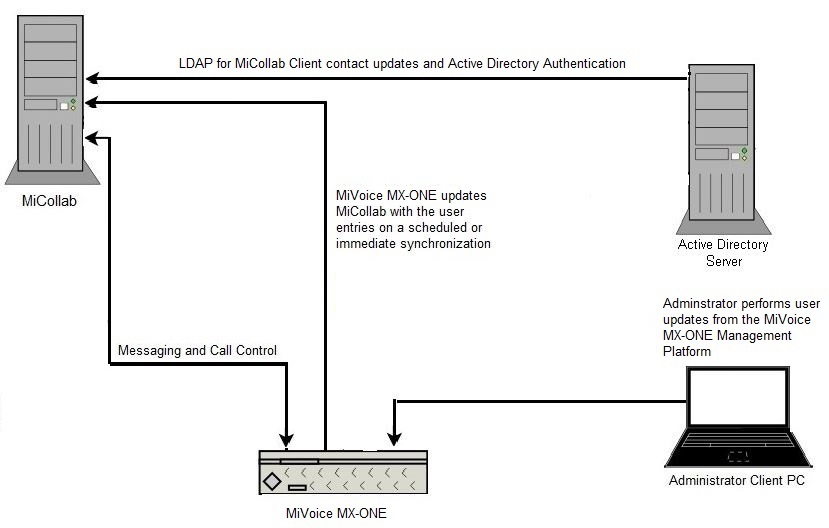Supported IDS Configurations
IDS is supported for the following configurations:
-
MiCollab and MiVoice Business (s) with Flow Through Provisioning
-
MiCollab and MiVoice Business (s) without Flow Through Provisioning
-
Single MiCollab Server and MiVoice 5000 Network with MiVoice 5000 Manager
MiCollab and MiVoice Business (s) with Flow Through Provisioning
If Flow Through Provisioning is enabled to an MiVoice Business system, IDS functions as follows:
-
You create or delete a user entry on the directory service. On the next polling interval all operations collected during the polling process are automatically processed on MiCollab .
-
When operations are processed, the user entries are displayed in the USP directory. If the directory service entry references a role, the corresponding template applies the phone and service data specified in that template to the users and services tabs in USP. If the directory service entry does not reference a role, the operation is sent to the detained queue of the USP Bulk Provisioning Tool.
-
Because Flow Through Provisioning is enabled, the phone services specified in the template are automatically programmed on the MiVoice Business system.
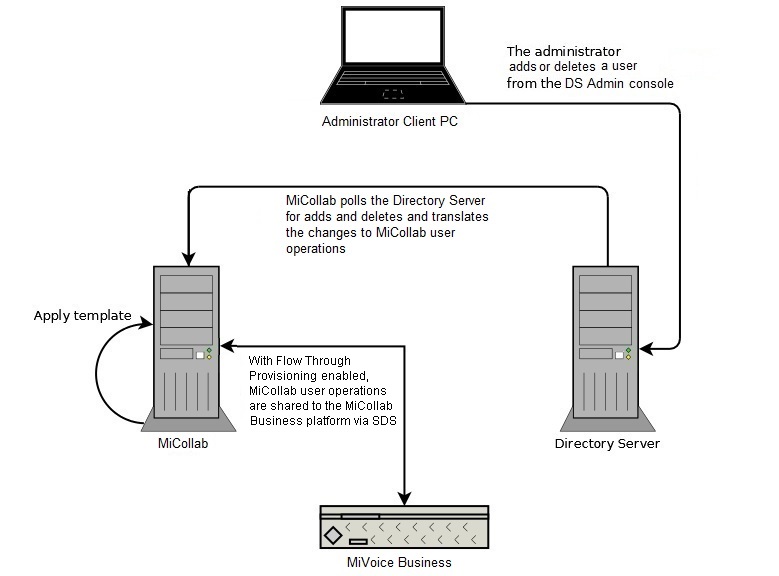
MiCollab and MiVoice Business (s) without Flow Through Provisioning
If Flow Through Provisioning to an MiVoice Business system is not enabled on MiCollab , IDS functions as follows:
-
You create or delete a user entry on the directory service. On the next polling interval all operations collected during the polling process are automatically processed on MiCollab .
-
When operations are processed, the user entries are displayed in the USP directory. If the directory service entry references a role, the corresponding template applies the phone and service data specified in that template to the users and services tabs in USP. If the directory service entry does not reference a role, the operation is sent to the detained queue of the USP Bulk Provisioning Tool.
-
Because Flow Through Provisioning is not enabled, the you must manually program the user data and phone services on the MiVoice Business system through the MiVoice Business System Administration Tool.
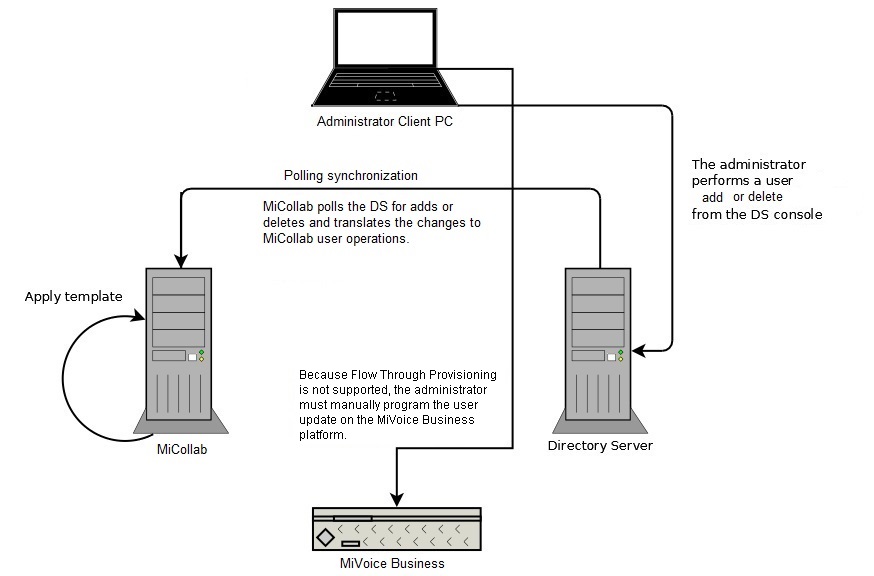
MiCollab and MiVoice Office 250 or Non-Mitel PBX
If MiCollab is deployed with a MiVoice Office 250 or non-Mitel PBX, IDS functions as follows:
-
You create, update, or delete a user/contact entry on the directory service. On the next polling interval all operations collected during the polling process are automatically processed on MiCollab .
-
When operations are processed, the user entries are displayed in the USP directory. If the directory service entry references a role, the corresponding template applies the phone and service data specified in that template to the users and services tabs in USP. If the directory service entry does not reference a role, the operation is sent to the detained queue of the USP Bulk Provisioning Tool.
-
Because Flow Through Provisioning is not supported, you must manually program the user data and phone services on the PBX.
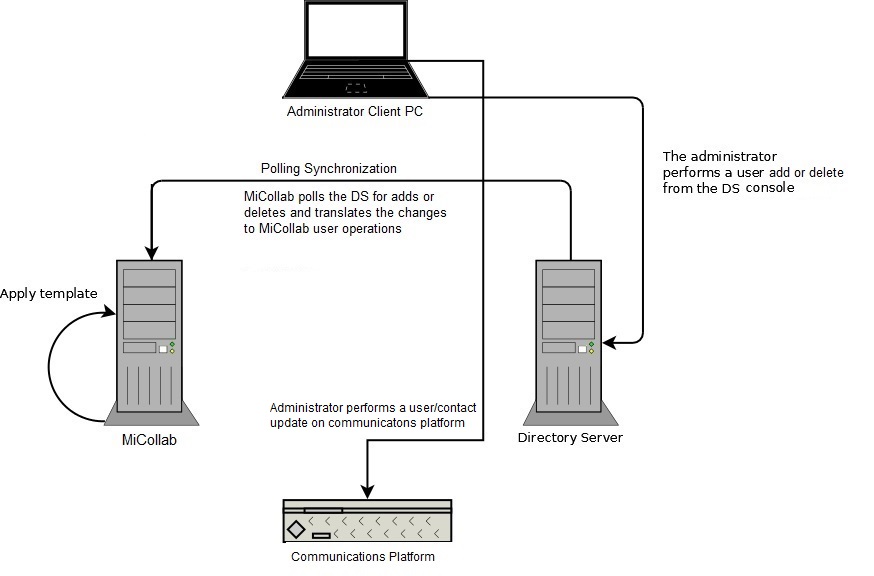
Multiple MiCollab Systems with Flow Through Provisioning to MiVoice Business
You can deploy multiple MiCollab systems in a network to support load sharing or services segregation among the MiCollab systems.
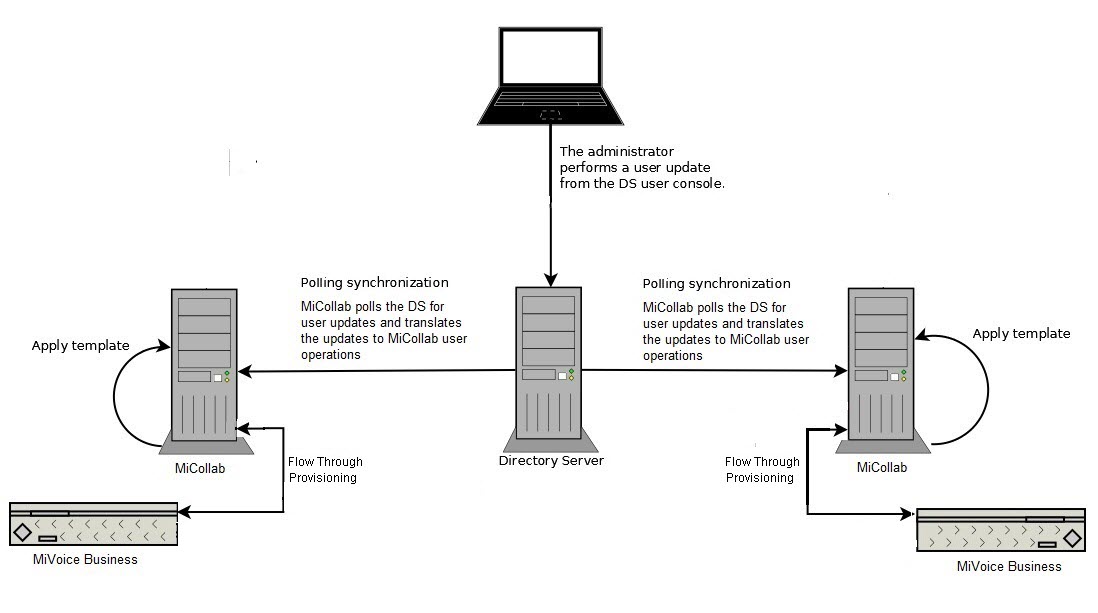
Single MiCollab Server and a Single MiVoice 5000
In this configuration, IDS provides MiCollab Client contact updates and supports Active Directory authentication for MiCollab users.
If MiCollab is deployed with a single MiVoice 5000 , the databases are synchronized as follows:
-
The administrator creates UCC roles and templates on the MiCollab system (or uses the default UCC roles and templates). During an initial synchronization with the MiCollab system, the MiVoice 5000 obtains the roles and templates from MiCollab .
-
After the administrator assigns a role to a user on the MiVoice 5000 , the MiCollab application services specified in the template are applied to the user on the next immediate or scheduled synchronization.
-
The IDS connection updates the MiCollab database with the MiCollab Client contacts from the directory service (within the MiVoice 5000 ).
-
An optional Active Directory server supports authentication of MiCollab users.
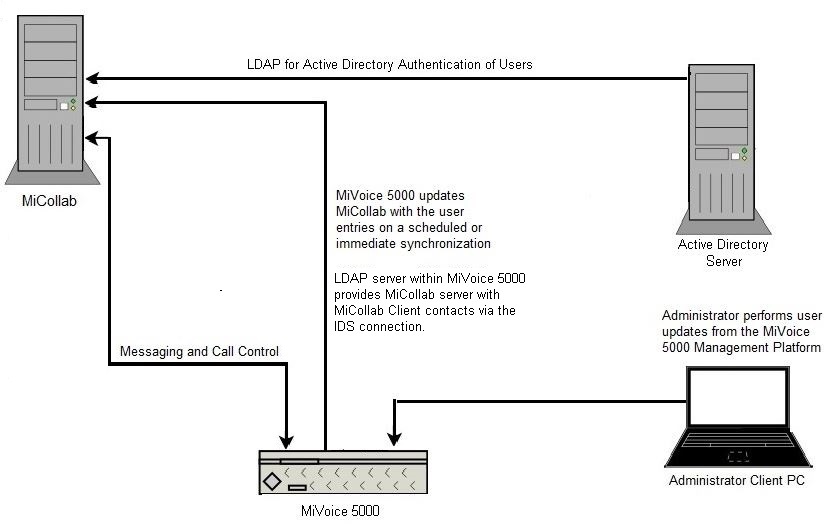
Single MiCollab Server and MiVoice 5000 Network with MiVoice 5000 Manager
In this configuration, IDS provides MiCollab Client contacts to MiCollab and supports the authentication of MiCollab users. If MiCollab is deployed with multiple MiVoice 5000 s the databases are synchronized as follows:
-
The administrator creates UCC roles and templates on the MiCollab system (or uses the default UCC roles and templates). During an initial synchronization with the MiCollab system, the MiVoice 5000 Manager obtains the roles and templates from MiCollab .
-
After the administrator assigns a role to a user on the MiVoice 5000 Manager, the MiCollab application services specified in the template are applied to the user on the next immediate or scheduled synchronization.
-
The IDS connection updates the MiCollab database with the MiCollab Client contacts from either the directory service in the MiVoice 5000 Manager or an optional Active Directory server.
-
An optional Active Directory server supports authentication of MiCollab users.

Single MiCollab Server and a Single MiVoice MX-ONE
In this configuration, IDS provides MiCollab Client contact updates and supports the authentication of MiCollab users.
If MiCollab is deployed with MiVoice MX-ONE , the databases are synchronized as follows:
-
The administrator creates UCC roles and templates on the MiCollab system (or uses the default UCC roles and templates). During an initial synchronization with the MiCollab system, the MiVoice MX-ONE obtains the roles and templates from MiCollab .
-
After the administrator assigns a role to a user on the MiVoice MX-ONE , the MiCollab application services specified in the template are applied to the user on the next immediate or scheduled synchronization.
-
The IDS connection updates the MiCollab database with MiCollab Client contacts from the Active Directory server. It also supports authentication of MiCollab users.
